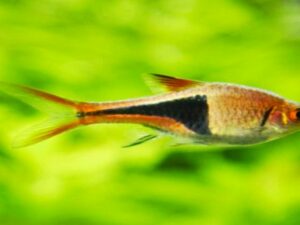The Moray Saltwater Eel is a species of saltwater eel that is found in the tropical and subtropical waters of the Indo-Pacific region. It is a popular aquarium fish due to its unique appearance and interesting behavior.
If you are thinking about jumping from “classic” fish to something more unorthodox, Morays make a unique alternative.
Moray Eels are becoming an increasingly popular choice for home aquariums. They are relatively easy to care for once you understand their basic needs and can provide years of enjoyment.
Its different species can be found in various colors, including brown, green, yellow, and white. Their undulating swimming motion is almost hypnotic and creates a completely different dynamic in your aquarium.
Around 200 species of Moray Eels exist, but only a handful are commonly seen in the aquarium trade. The most popular species include the Snowflake Moray, Green Moray, and Golden tail Moray.
They are from the family of Anguilliformes, the family of eels containing all of the true eels. Moray Eels are predators and scavengers, feeding on smaller fish, crabs, shrimp, squid, and octopuses. These eels are saltwater eels and are found in all of the world’s oceans.
Moray Eels have a distinctive appearance, unlike any other type of fish. They are long and slender, with large mouths full of sharp teeth. Their bodies are covered in a layer of mucus that helps them to move easily through the water and protects their skin.
Out of the 200 species of eels, only 12 are considered suitable for a home aquarium, while only five are considered safe for housing with other fish. Their size and weight differ dramatically between species as well.
This restricted selection includes two of the most popular species, the Snowflake (Echidna nebulosa) and the Zebra Moray (Gymnomuraena zebra).
They come in a wide range of varieties. Some species have patterned or banded skin, while others are a single color. The Snowflake Moray is one of the most popular, with its beautiful white and black marbled pattern.
Whatever species you choose, be prepared for a long-term commitment. These eels can live for 20 years or more with proper care.
People think they are menacing and aggressive creatures because of their large mouths full of razor-sharp teeth. However, they are quite shy and reclusive by nature.
They spend most of their time hiding in caves or crevices in the reef, only emerging to feed on smaller fish or invertebrates. Moray Eels are solitary creatures in the wild, only coming together to mate.
Table of Contents
Specie Summary
| Family: | Muraenidae |
| Size: | 4.5-156 inches |
| Lifespan: | 10-20 years |
| Color: | Various |
| Care Level: | Moderate |
| Temperament: | Semi-aggressive |
| Diet: | Carnivore |
| Minimum Tank Size: | 15-30 gallons |
| Tank Setup: | Marine: corals and crevices |
| Compatibility: | Large, robust fish |
Moray Eel Availability
Moray Eels are not commonly found in pet stores but can be purchased online. They are also sometimes available through public aquariums that have breeding programs.
When you find somewhere that sells the species you want, you may have to wait a while as they are not always available. It is hard for a store to maintain stocks because they must rely on wild-caught fish, which are hard to breed in captivity.
The price of a Moray eel can vary depending on the species, but they are generally not cheap. A small Snowflake Moray can cost around $50, while a large Goldentail Moray can be over $200. Prices will vary depending on the size and species of the Moray you want and where you are buying it from.
Moray Eels Appearance
Moray Eels have a long, snake-like body that is covered in mucus. This mucus helps reduce friction as they move through the water and protects their skin from parasites and diseases. They have large mouths full of sharp teeth, and their eyes are on the sides of their head.
Moray Eels come in various colors, from black and white to yellow and green. Some species have patterns on their skin, while others are a single color.
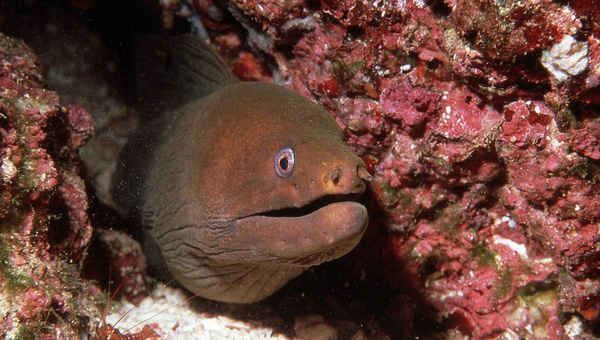
Most of their bodies lack anatomical structures since most species lack pectoral and pelvic fins. The exception is the dorsal fin which runs from the base of the head to the tail, fusing with the caudal and anal fins.
The most popular species include the Snowflake Moray, which has a white and black marbled pattern, and the Zebra Moray, which has vertical stripes of black and white.
It is virtually impossible to determine their sex of them with the naked eye, making it hard to breed them in captivity. The pharyngeal jaws are brought to the front of the mouth to grab prey and pull it into the body.
Gills can be found at the rear of the head and are usually small and round. They must keep their mouth open to supply the gills with water for respiration.
Since there are roughly 200 species, it can be expected that appearance will vary between them. Many Morays have a distinctive look which makes them easily identifiable. This could be a vibrant color or a striking pattern. A species’ common name usually gives you a good idea of its appearance.
The winner for longest is the slender giant Moray (Strophidon sathete), reaching 13 feet (4 m), while the smallest, Snyder’s Moray (Anarchias leucurus), is all the way down at 4.5 inches (11.5 cm).
Also, check How To Cure Fish Fungus (Aquarium Fish) Ultimate Treatment & Medication
Following are some other popular varieties of eels:
- Jewel Moray (Echidna nebulosa)
- Giant Moray (Gymnothorax javanicus)
- Zebra Moray (Gymnomuraena zebra)
- Dragon Moray (Enchelycore pardalis)
- Honeycomb Moray (Muraena helena)
- Snowflake Moray (Echidna nebulosa)
- Golden tail Moray (Gymnothorax miliaris)
- Peppermint Moray (Gymnothorax hubbsi)
Moray Eel Size and Growth Rate
Moray Saltwater Eels come in a wide range of sizes, from the tiny Pygmy Moray that only grows to 4.5 inches to the giant Green Moray, which can reach 156 inches long. Most species fall between these two extremes, with most adults reaching 2-3 feet long.
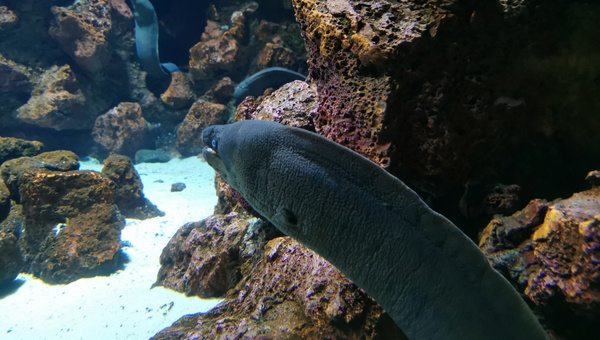
The growth rate of Moray Eels varies depending on the species, but they are generally slow growers. Some species, like the Snowflake Moray, can take up to 5 years to reach their full size, while others, like the Golden tail Moray, can grow much faster and reach their full size in just two years.
Check Otocinclus Catfish Care Guide: Appearance, Lifespan, Food & Diet, Breeding & All
Moray Eels Lifespan
Moray Eels have a long lifespan, with some species living for over 20 years in captivity. The average lifespan of most species is 10-15 years, but this can vary depending on the individual and the tank’s conditions
Moray Eels Behavior and Temperament
Moray Eels are generally peaceful fish but can be aggressive toward other fish. It is best to keep Moray Eels with other peaceful fish that are too big to be eaten. Some good tank mates for Moray Eels include clownfish, tangs, wrasses, and grouper
Moray Eels are nocturnal fish, so they are most active at night. During the day, they often hide in caves or among the rocks.
We should never keep these fish with poisonous or mildly poisonous ones like pufferfishes, lionfishes, and even Moray Eels.
Moray Eels Breeding
It is tough to breed them in captivity. The main reason is that they are tough to have sex with.
There is currently no known way to have sex with Moray Eels. If you can breed Moray Eels successfully, the eggs will be deposited in a cave or among the rocks.
The eggs will hatch in about 2-3 weeks. After hatching, the fry will be free-swimming and should be fed small live foods. The fry will grow quickly and reach sexual maturity in about 1-2 years.
Check Tomini Tang Fish Care Guide: Appearance, Breeding & All
Following are some tips for breeding Moray Eels:
- Using a pair of Moray Eels from the same species is best.
- The pair should be of similar size and age.
- The female will lay eggs in a cave or among the rocks.
- The male will then fertilize the eggs.
Moray Eels Care Guide
Moray Eels are not recommended for beginners, and experienced aquarists should only keep them. This is because they are susceptible to water conditions and can be difficult to care for. They are also aggressive predators that eat anything that fits into their mouths, including other fish and invertebrates.
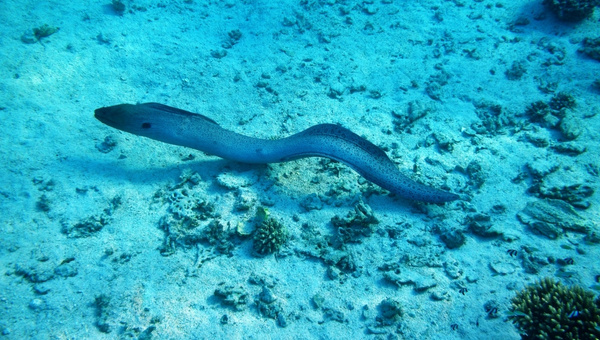
Before you decide to get a Moray eel, make sure you do your research and understand the care requirements. These eels need a large tank with plenty of hiding places. They should also be kept with other aggressive fish that can hold their own against the eel.
Most health issues will come from poor water conditions, feeding, or attacks from other fish, but occasionally Morays can suffer from skin lesions or inflammation.
You may also check Bellus Angelfish Care: Appearance, Size, Lifespan, Diet & All
Moray Eels Food and diet
Moray Eels are carnivores, and their diet should consist of meaty foods. Some good options for meaty foods include Live fish, frozen fish, shrimp, squid, crabs, and clams. Feeding your Moray eel various foods is important to ensure they get all the necessary nutrients.
A varied diet will also help to keep your Moray eel healthy and prevent nutritional deficiencies. You should feed your Moray eel 2-3 times per day.
Feeding your Moray eel as much as possible in one sitting is important. Overfeeding can lead to problems such as obesity and digestive issues. If you are unsure how much to feed your Moray eel, consult a veterinarian or aquaculture specialist.
Moray Eels Tank Mates
Following are some of the good tank mates for Moray Eels:
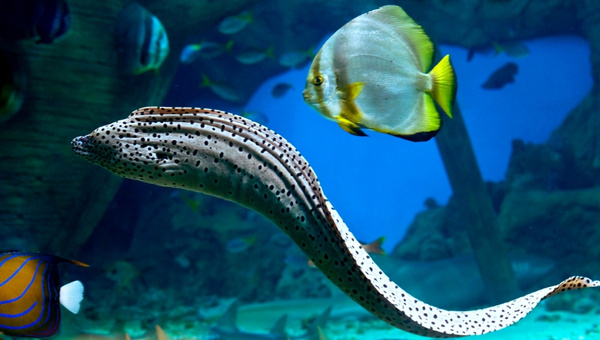
Some of the bad tank mates for Moray Eels are:
- Fishes that are smaller in size (as they might get eaten)
- Fishes with similar aggression levels (as they might fight)
- Fishes that are not compatible with the eel’s nocturnal lifestyle (as they might not get the proper rest)
- Fishes that are poisonous or mildly poisonous (as they might get hurt)
- Fishes that require a different diet (as they might not get the proper nutrition)
- Fishes that have different water requirements (as they might not be able to survive in the eel’s environment)
Also, check Sand Sifting Starfish 101: Care, Appearance, Lifespan, Diet & All
Moray Eels Tank Size
Moray Eels need a large tank with plenty of hiding places. A 50-gallon (190 L) tank is the minimum size for housing one of these eels, but a larger tank is always better. The largest ones (larger than 10 feet) are rarely kept in the home aquarium due to trouble with providing adequate space.
Individuals reaching 2.5 feet or more by adulthood should be kept in at least a 30-gallon tank. “Mini-Morays” (less than 15 inches) will be comfortable in tanks as small as 15 gallons.
Water Conditions
Moray Eels are very sensitive to water conditions and require high-quality water. The water should be well-oxygenated and have a pH of 8.1 to 8.4. The temperature should be 72° to 78° Fahrenheit.
It is worth noting that due to the curious nature of Morays, tanks should be fitted with a secure cover with no gaps. Saltwater eels will likely investigate the tank’s exterior, given a chance.
Ensure that water changes are conducted every 1 to 2 weeks to prevent the buildup of nitrogenous waste. Wet-dry and canister filters are good examples to help maintain suitable water quality.
Following are some parameters that should be kept in mind while setting up a tank for Moray eel:
- pH: 8.1 to 8.4
- Temperature: 72° to 78°Fahrenheit (22° to 26°Celsius)
- Water changes: every 1-2 weeks
Filtration
When we talk about the filter, we need to consider the two main types of filters: biological and mechanical.
Biological filters help to break down ammonia and nitrites, while mechanical filters remove physical debris from the water.
Having both filters in your Moray eel tank is important because they work together to keep the water clean and the eels healthy. A good rule of thumb is to choose a filter that can turn over the tank’s water volume at least ten times per hour.
You may also check Pipefish 101:Care, Appearance, Diet, Breeding, Lifespan & All
Following are some well-recommended filters for Moray eel tanks:
- Fluval FX6 Canister Filter
- Sump Filter
- AquaClear 70 Powerhead Filter
Heating
Moray Eels need a water heater to maintain a consistent water temperature. The heater should be strong enough to raise the tank’s temperature by 10 degrees Fahrenheit (5.6 degrees Celsius).
It is also important to have a thermometer in the tank to monitor the water temperature and ensure it stays within the ideal range.
Following are some well-recommended heaters for Moray eel tanks:
- Fluval E Series Heater
- Hydor ETH In-Line External Aquarium Heater
Check Pictus Catfish Care: Lifespan, Breeding, Food & Diet
Lighting
Moray Eels do not need special lighting, but you may want to provide some lighting to show off their colors. A standard fluorescent tube light will be sufficient.
When choosing a light bulb, ensure it is the correct size for your tank. Also, remember that the light should not be too bright or dim. A good rule of thumb is to choose a light bulb that is about one-third the wattage of your aquarium size in gallons.
Following are some well-recommended light bulbs for Moray eel tanks:
- Zoo Med Repti Sun 5.0 UVB Fluorescent Tube
- Arcadia 6% T5 HO Aquarium Bulb
Substrate
The substrate is the material you put at the bottom of the tank. It can be anything from sand to gravel to rocks.
Some prefer sand because it is easier to clean and does not get caught in the eel’s gills. However, sand can also be a problem because it can get into the eel’s mouth and cause problems.
Gravel is a good choice for the substrate because it is easy to clean and does not get caught in the eel’s gills. It is also available in various colors, so you can choose something to complement your eel’s coloration.
Rocks are another good choice for the substrate because they are easy to clean and do not get caught in the eel’s gills. Rocks can also be used to create hiding places for your eel.
Also, check Silver Dollar Fish 101: Care, Diet, Appearance, Breeding & All
Following are some well-recommended substrates for Moray eel tanks:
- Fluval Sea Marine Reef Salt
- Instant Ocean Reef Crystals
Decorations
Moray Eels need hiding places where they can feel safe and secure. This can be achieved using rocks, caves, or other decorations to create hiding spots. It is important to ensure the decorations are securely placed, so they do not fall and hurt the eel.
Anemones are a good decoration choice because they provide hiding places for the eels and help filter the water. Anemones are available in various colors, so you can choose something to complement your eel’s coloration.
Coral is another good decoration choice because it provides hiding places for the eels and helps filter the water. Coral is available in various colors, so you can choose something to complement your eel’s coloration.
Driftwood is a good decoration because it provides hiding places for the eels and helps filter the water. Driftwood is available in various colors, so you can choose something to complement your eel’s coloration.
Following are some well-recommended decorations for Moray eel tanks:
- Anemone Decoration
- Coral Decoration
- Driftwood Decoration
Check Paradise Fish Care Guide, Appearance, Food, Size & All
Water Changes
Moray Eels produce a lot of waste, so it is important to do regular water changes. Water changes also help to keep the water quality high and prevent problems such as algae growth.
Water changes should be done on a weekly basis, and the amount of water that is changed should be about 50%.
Following are some good recommended products for water changes:
- Fluval Sea Salt
- Instant Ocean Reef Crystals
Cleaning the tank
You should perform a partial water change of 25% every other week. You will also need to vacuum the gravel and clean the filter media. Rinse the filter media in old tank water to prevent disrupting the beneficial bacteria colony.
To clean the tank, you will need the following:
- A sponge: A sponge can be used to wipe down the inside of the tank.
- A toothbrush: To clean the filter, we will use a toothbrush.
- Freshwater: You will need fresh water to rinse off the sponge and toothbrush.
Also, check Ryukin Goldfish Care, Lifespan, Behaviour, Diet & All
The steps for cleaning the tank are as follows:
- Remove the fish from the tank and put them in a temporary home.
- Remove all of the decorations from the tank.
- Use the sponge to wipe down the inside of the tank.
- Rinse the sponge and toothbrush with fresh water.
- Use the toothbrush to clean the filter.
- Rinse the sponge and toothbrush with fresh water.
- Add the decorations back to the tank.
- Add the fish back to the tank.
It is essential to clean the tank on a regular basis to prevent the build-up of algae and bacteria. Algae and bacteria can be harmful to fish, and they can also cause the water to become cloudy.
Cleaning The Filter
It is essential to clean your filter on a regular basis. A dirty filter can cause problems for your fish.
To clean your filter, you will need the following:
- A clean bucket: We can use a clean bucket to hold the old water.
- A garden hose: To rinse the filter media, we can use a garden hose.
- Filter media: This is used to replace the old media.
To start, you will need to remove the filter from your tank. Then, use the clean bucket to hold the old water. Next, use the garden hose to rinse the filter media.
Moray Eel Common Possible Diseases
There are a few diseases that Moray Eels are susceptible to, and these include:
- Ich: This is a common disease that is caused by a parasite. Ich can be treated with medication, and it is important to raise the temperature of the water to help kill the parasites.
- Bacterial Infections: The second most common disease is bacterial infections. Bacterial infections can be treated with medication, and it is important to maintain good water quality to prevent the infection from spreading.
- Fungal Infections: Next common disease is fungal infections. Fungal infections can be treated with medication, but it is important to maintain good water quality to prevent the infection from spreading.
If you suspect your fish has any of these diseases, it is important to take them to a vet for a diagnosis and treatment.
Also, check Killifish Ultimate Care Guide, Size, Diet, Breeding, Tankmates & All
Moray Eel Treatment And Medication For Diseases
A few different medications can be used to treat diseases in Moray Eels.
- For Ich, the most common medication is formalin. Formalin is a toxic chemical, so it is important to use it as directed.
- For bacterial infections, the most common medication is antibiotics. Antibiotics can harm fish, so it is important to use them as directed.
- For fungal infections, the most common medication is an antifungal medication. Antifungal medication can harm fish, so it is important to use it as directed.
If you suspect your fish has any of these diseases, it is important to take them to a vet for a diagnosis and treatment.
There are a few things that you can do to prevent diseases in your Moray Eels are as follows:
- First, it is important to maintain good water quality. This means performing regular water changes and vacuuming the gravel.
- Second, it is important to quarantine new fish before adding them to your tank. This will help to prevent the spread of diseases.
- Third, it is important to avoid overfeeding your fish. Overfeeding can lead to problems such as obesity and digestive issues.
- Fourth, it is important to provide your fish with a varied diet. A varied diet will help to keep your fish healthy and prevent nutritional deficiencies.
- Fifth, it is important to provide your fish with a stress-free environment. A stress-free environment will help to prevent diseases.
Finally, taking your fish to the vet for regular check-ups is important. This will help to catch any diseases early and treat them before they become serious.
Check Betta Fish 101: Diet, Lifespan, Size, Care Guide & All
Things To Consider Before Buying Moray Eel
Following are a few things to consider before buying a Moray Saltwater Eel:
- Do your research: Be sure to research before buying a Moray Saltwater Eel. Learn about their habitat, diet, and care requirements. This will help you determine if this fish is right for your aquarium.
- Get a professional opinion: As mentioned above, it is always a good idea to consult a professional before adding new fish to your tank. They can help you determine if a Moray Saltwater Eel is right for your aquarium and offer advice on care and diet.
- Be prepared for the worst: Moray Saltwater Eels are not known for longevity. They have a lifespan of 5-10 years, which is shorter than most other fish. This means you must be prepared for the possibility that your Moray Saltwater Eel may not live very long.
- Be prepared to care for them properly: As mentioned above, Moray Saltwater Eels require much care and attention. They must be fed frequently, and their tanks must be cleaned often. If you are not prepared to care for them properly, they will not thrive.
Check Tiger Shovelnose Catfish 101: Best Detailed Guide
Advantages Of Having Moray Eel In Your Tank
- Moray Saltwater Eel can help to keep the aquarium clean by eating uneaten food and dead fish.
- They are also known to control pests in the tank, such as crabs and shrimp.
- Some believe having a Moray Saltwater Eel in the tank will bring good luck.
- Moray Saltwater Eels are very active and interesting to watch. They have a unique appearance and can add excitement to your tank.
Disadvantages Of Having Moray Eel In Your Tank
- Moray Saltwater Eel can be very aggressive, particularly when they are hungry. They have been known to attack and kill other fish in the tank.
- They can also threaten humans and should be handled with care. If a Moray Saltwater Eel bites you, it can be excruciating, and you may need medical attention.
- Moray Saltwater Eels require a lot of food and can quickly make a mess of your tank if not fed properly.
- They can also be messy eaters, so you must clean up after them frequently.
Also, check Black Ghost Knife Fish 101: Best Detailed Guide & More
Conclusion
Moray Saltwater Eels are not recommended for beginner aquarium hobbyists. They require much care and attention and can be difficult to keep alive. If you want to bring a touch of outlandishness into your home, Morays might be right.
However, if you are not prepared to care for them properly, they will not thrive and may not live very long.
Before adding a Moray Saltwater Eel to your tank, be sure to do your research and consult with a professional. This will help you determine if this type of fish is right for your aquarium, offer advice on care and diet, and ensure you are prepared to care for them properly.



